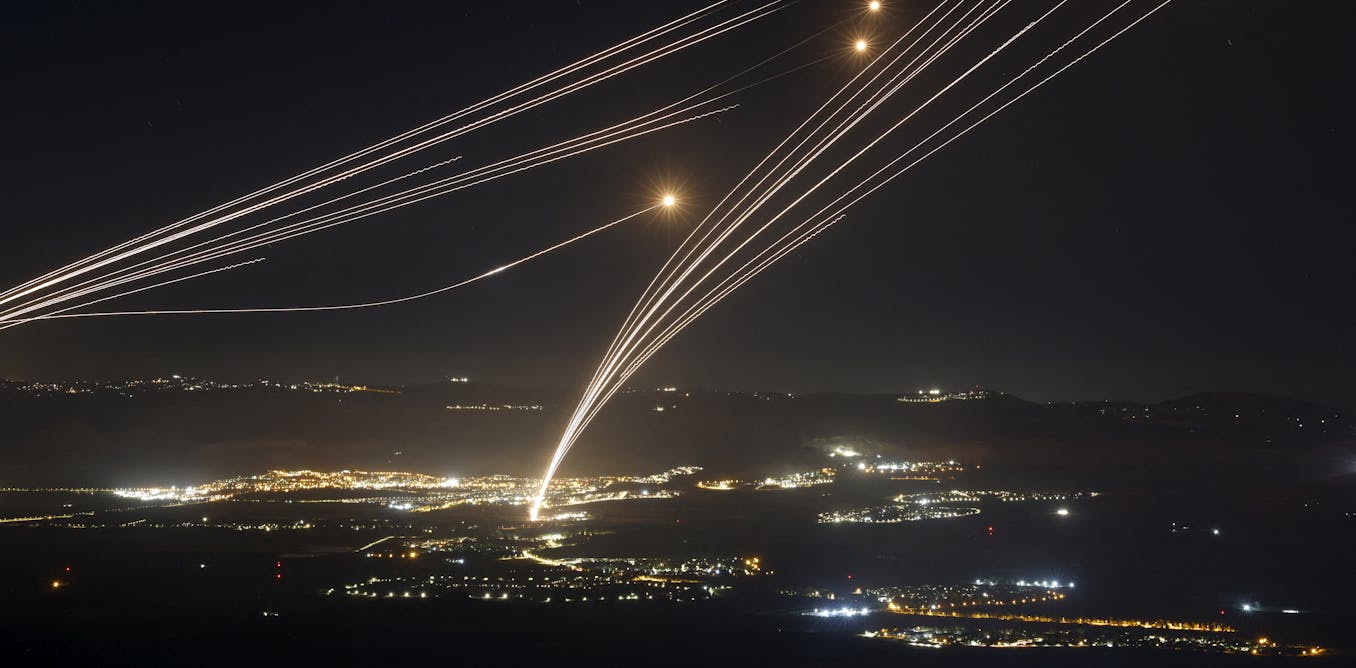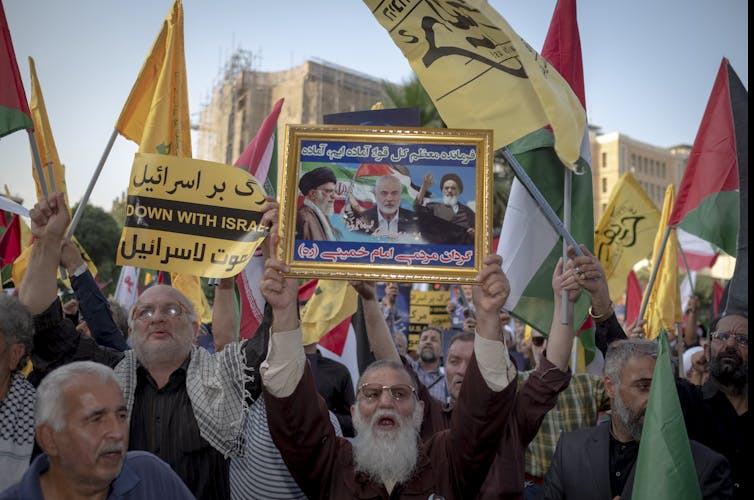
The escalating conflict between Israel and Iran in recent months is frequently explained as another extension of Israel’s war on Hamas in Gaza. After all, Hamas enjoys a close relationship with Iran, and both share the goal of eliminating the Jewish state.
But there’s more to it than that.
As a scholar of security studies who has researched conflicts in the Middle East for over 20 years, I would argue that a decade of U.S. foreign policy in the region has failed to contain Iran’s ambitions and has instead substantially contributed to the current escalation.
As is clear from recent events along Israel’s northern border, Washington’s ability to project power and manage American interests in the Mideast has eroded so dramatically since 2010 that Iran has only limited concerns about the consequences of its proxies attacking U.S. forces and directly attacking U.S. allies such as Israel.
Iranian victories
The government of Iran, a Shia Muslim nation in a Sunni Muslim region, expands its regional influence by funding and militarily supporting violent proxy organizations in neighboring countries. Those groups, in turn, attack and destabilize those nations.
Over the past decade, this canny strategy has turned Iran arguably into the Mideast’s most influential superpower.
Until the early 2010s, Iran’s only real foothold in the region was Hezbollah, the Shia political and military group it fostered in Lebanon in the early 1980s. Today, Iran’s alliances include the Houthi rebels in Yemen and a loyal network of Shia militias in Iraq. In Syria, President Bashar al-Assad has allowed Iran’s elite fighting force, the Islamic Revolutionary Guard, to build a massive military presence.
Since Oct. 7, 2023, when Hamas invaded Israel, triggering the Gaza war, these groups have directly attacked Israel, American military bases and U.S. civilian assets in the region over 170 times. The political and military sovereignty of Syria, Yemen, Lebanon and Iraq has so eroded that some American officials consider them Iran’s puppet regimes.
Over the same period, Iran’s military nuclear program has reached its most advanced stage. In July 2024, six years after the Trump administration backed out of the international nuclear deal meant to slow the development of Iranian weapons, U.S. Secretary of State Antony Blinken warned that Iran was weeks from being able to equip its vast and growing arsenal of ballistic missiles with nuclear warheads.
Misconceptions, containment and oversimplified diplomacy
Despite Iran’s many recent military and political advances over the past decade, the American government has consistently underestimated its ambitions of regional dominance. Simultaneously, in my assessment, it has overvalued the effectiveness of long-standing U.S. “soft power” policies toward Iran: containment and de-escalation.
To avoid escalating conflict in the Mideast, Washington prioritizes actions that will avoid, at almost any cost, any military confrontation with Iran. Instead, to contain Iran’s expanding regional influence, the U.S. has banned arms sales and technology to Iran, imposed stringent economic sanctions, frozen Iranian financial assets and diplomatically isolated its government.
Yet, Iran’s influence continues to expand. In my assessment, this indicates that containment and de-escalation cannot deter a regime whose core policies are driven by fundamentalist ideology. Iran’s leaders invoke religious convictions to justify their commitment to violent struggle, regional superiority and the destruction of Israel.
“Allah willing, there will be no such thing as a Zionist regime in 25 years,” said Iran’s Supreme Leader Ayatollah Ali Khamenei, in 2015, calling the fight to annihilate Israel a matter of “jihadi morale.”
I consider diplomacy, negotiation and legal and economic punishments preferable solutions for most global conflicts. Yet modern history shows that these measures cannot force policy change on nondemocratic, fundamentalist regimes that flout the rules of global international relations – think Nazi Germany, North Korea and the Afghan Taliban regime.
How not to deal with proxies
My scholarship on terrorist groups suggests that the U.S. has erred in its handling of Iran’s proxies, too. Rather than addressing them together as part of a hostile network, the U.S. treats each proxy as an isolated actor operating in a specific place and seeks to contain or de-escalate that particular threat.
In Yemen, for example, the U.S. did not stop the Iran-backed Houthi rebels from seizing territory and essentially supplanting the government. The Biden administration even pressured U.S. ally Saudi Arabia in 2021 to stop militarily boosting the country’s legitimate leaders in their bloody fight to retain power. After the Gaza war began, the Houthis, doing Iran’s bidding, began lobbing dozens of missiles at Western-flagged ships in the Red Sea.
Only in early 2024 did the U.S. confront the Houthis, making retaliatory military strikes on Houthi bases in Yemen.
In Iraq, the U.S. was long willing to overlook that Iran was backing the Iraqi Shia militias battling the Islamic State group, as long as these forces continued to participate in the war on the Islamic State. Ignoring the long-term consequences of their growing strength has come at a cost: In the past year, those Iraqi militias have attacked numerous American military bases in the region.
And in Syria, despite Iran’s rising influence in the aftermath of the Syrian civil war, the U.S. has gradually reduced its support for anti-Assad rebels and pro-democracy Kurdish forces.

Collapse of American deterrence
All these failed foreign policies have culminated in the collapse of American deterrence in the Middle East. Simply put, the U.S. no longer projects enough power there to stop Iranian hostilities.
In April 2024, after Israel killed high-ranking officials in Iran’s embassy complex in Syria, Iran launched one of the largest missile attacks in history, lobbing over 300 missiles at Israel – its first-ever direct attack on Israel. Yet it has suffered marginal consequences, mainly economic sanctions and diplomatic outcry.
The U.S., which rallied Israel’s allies across the Mideast to shoot down most of the Iranian missiles, again preferred to block a meaningful response. The Biden administration declared the fact that few missiles hit Israel to be a “win” and insisted that the U.S. would not join Israel in any retaliation against Iran.
America’s deep aversion to escalation was further exposed after the targeted killings of top Hezbollah and Hamas leaders. In late July 2024, Hezbollah commander Fuad Shukr was killed in an Israeli airstrike in Beirut, Lebanon, and Hamas leader Ismail Haniyeh was killed in a bombing at a government guesthouse in Iran. Iran blamed Israel for Haniyeh’s killing; The New York Times reported that assessment was “also reached by several U.S. officials who requested anonymity.”
Iran immediately vowed to retaliate.
For months, the U.S. had pressured Israel to adopt more precision-based military operations to avoid further civilian casualties in the Gaza war, which had killed nearly 40,000 people in its first six months. Yet when Israel apparently finally did that, eliminating specific terrorists responsible for killing Israelis and Americans, American policymakers fretted that such cross-border attacks could lead to regional escalation.
If the U.S. seeks to achieve long-term peace in the Middle East, it must first acknowledge the failures of the past decade. The evidence backs my conclusion that Iran is an enemy that cannot simply be deterred, contained or de-escalated.![]()
Arie Perliger, Director of Security Studies and Professor of Criminology and Justice Studies, UMass Lowell
This article is republished from The Conversation under a Creative Commons license.

